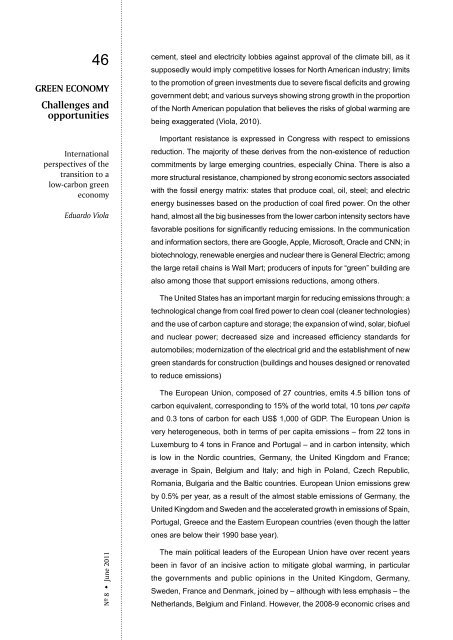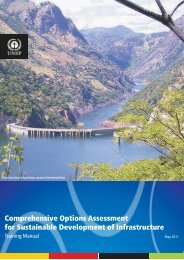Download Publication - Rio+20
Download Publication - Rio+20
Download Publication - Rio+20
Create successful ePaper yourself
Turn your PDF publications into a flip-book with our unique Google optimized e-Paper software.
46<br />
GREEN ECONOMY<br />
Challenges and<br />
opportunities<br />
International<br />
perspectives of the<br />
transition to a<br />
low-carbon green<br />
economy<br />
Eduardo Viola<br />
cement, steel and electricity lobbies against approval of the climate bill, as it<br />
supposedly would imply competitive losses for North American industry; limits<br />
to the promotion of green investments due to severe fiscal deficits and growing<br />
government debt; and various surveys showing strong growth in the proportion<br />
of the North American population that believes the risks of global warming are<br />
being exaggerated (Viola, 2010).<br />
Important resistance is expressed in Congress with respect to emissions<br />
reduction. The majority of these derives from the non-existence of reduction<br />
commitments by large emerging countries, especially China. There is also a<br />
more structural resistance, championed by strong economic sectors associated<br />
with the fossil energy matrix: states that produce coal, oil, steel; and electric<br />
energy businesses based on the production of coal fired power. On the other<br />
hand, almost all the big businesses from the lower carbon intensity sectors have<br />
favorable positions for significantly reducing emissions. In the communication<br />
and information sectors, there are Google, Apple, Microsoft, Oracle and CNN; in<br />
biotechnology, renewable energies and nuclear there is General Electric; among<br />
the large retail chains is Wall Mart; producers of inputs for “green” building are<br />
also among those that support emissions reductions, among others.<br />
The United States has an important margin for reducing emissions through: a<br />
technological change from coal fired power to clean coal (cleaner technologies)<br />
and the use of carbon capture and storage; the expansion of wind, solar, biofuel<br />
and nuclear power; decreased size and increased efficiency standards for<br />
automobiles; modernization of the electrical grid and the establishment of new<br />
green standards for construction (buildings and houses designed or renovated<br />
to reduce emissions)<br />
The European Union, composed of 27 countries, emits 4.5 billion tons of<br />
carbon equivalent, corresponding to 15% of the world total, 10 tons per capita<br />
and 0.3 tons of carbon for each US$ 1,000 of GDP. The European Union is<br />
very heterogeneous, both in terms of per capita emissions – from 22 tons in<br />
Luxemburg to 4 tons in France and Portugal – and in carbon intensity, which<br />
is low in the Nordic countries, Germany, the United Kingdom and France;<br />
average in Spain, Belgium and Italy; and high in Poland, Czech Republic,<br />
Romania, Bulgaria and the Baltic countries. European Union emissions grew<br />
by 0.5% per year, as a result of the almost stable emissions of Germany, the<br />
United Kingdom and Sweden and the accelerated growth in emissions of Spain,<br />
Portugal, Greece and the Eastern European countries (even though the latter<br />
ones are below their 1990 base year).<br />
Nº 8 • June 2011<br />
The main political leaders of the European Union have over recent years<br />
been in favor of an incisive action to mitigate global warming, in particular<br />
the governments and public opinions in the United Kingdom, Germany,<br />
Sweden, France and Denmark, joined by – although with less emphasis – the<br />
Netherlands, Belgium and Finland. However, the 2008-9 economic crises and

















